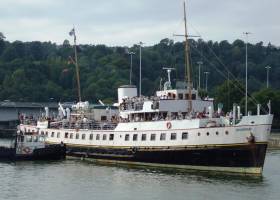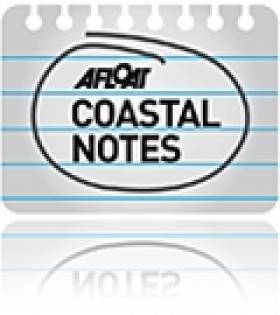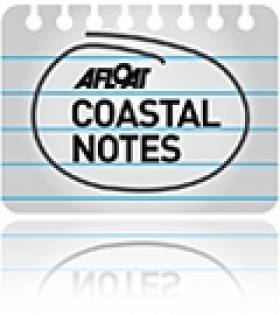Displaying items by tag: MV Balmoral
Wave Of Seasickness As Pleasure Cruise Turns Sour In Poor Weather
#Seasick - A pleasure cruise on the Irish Sea at the weekend turned sour when severe weather prompted a wave of seasickness.
Mail Online reports that some passengers on board the MV Balmoral were vomiting for up to six hours as they were ‘thrown around like rag dolls’ on the decks of the vintage liner.
The trouble began when the excursion ship hit choppy waters an hour into its passage from Liverpool to Llandudno in North Wales.
After two hours of violent lurching in the water, the ship’s 390 passengers were told they would not be docking in Llandudno due to the severe conditions — meaning another three hours of ‘torture’ at sea as the vessel returned to Liverpool.
An elderly woman was tended to by paramedics on arrival as the rest of those on board recovered from their ordeal back on dry land.
One passenger wrote on social media in the aftermath: “I have never seen so many strangers throwing up in front of each other.”
Mail Online has much more on the story HERE.
Excursion Day-Trips to Mull of Kintyre and Isle of Man
#EXCURSIONS – A series of day-long round trip excursion cruises, offering unusual routes from Northern Ireland to destinations in Scotland and the Isle of Man are to start before and during this weekend, writes Jehan Ashmore.
The excursions are running this Friday, Saturday and Sunday (7-9 September) and are operated by Glasgow based Waverley Excursions which will be running their classic Balmoral (1949/736grt) on the following dates and ports, for details see further down below.
Commenting on Balmoral's forthcoming excursions Captain Andy O'Brian said: "There is no better way to spend the day than relaxing on deck and watching the spectacular scenery slip by. We look forward to welcoming our regular passengers from Northern Ireland and hope to see some new faces."
Balmoral is a former Isle of Wight ferry and Bristol Channel excursion vessel now in her 63rd year and she can carry 150 people. Facilities include an Art Deco restaurant offering a buffet style menu. The Lower Bar also designed in 1930's Art Deco style, serves hot and cold snacks too and sandwiches, while the Britannia Lounge Bar has windows running down either side for added sightseeing opportunities.
Balmoral's Excursions Schedule
Friday 7 September: Sail from Ballycastle and Redbay to Campbeltown (Mull of Kintyre) and take in the views of the famous peninsula and Sanda Isles, where the excursion schedule allows for an afternoon visit ashore.
Saturday 8 September: Sail from Londonderry / Derry to the spectacular scenery of Islay in Scotland's Western Isles, and where an afternoon can be spent ashore in Port Ellen.
Sunday 9 September: Sail from Portaferry you can visit the Isle of Man, with another unusual route opportunity by visiting Peel, situated on the west coast of the island. Again the excursion permits an afternoon ashore in the charming coastal town.
Children under five travel free and ages 5 - 17 travel at half the adult fare. A discount of 10% for groups of 10 or more is on offer from the operator. For further details including a brochure or to book tickets call 0845 130 4647. Alternatively tickets can be purchased from Tourist Information Centres in Ards, Larne and Portaferry and online www.waverleyexcursions.co.uk/north.htm
Balmoral as previously reported on Afloat.ie, is a veteran of coastal excursions and in Weymouth, she took spectators to watch the sailing events during the London 2012 Olympics.
Round Anglesey Cruise
#ROUND ANGLESEY CRUISE – A 'Round Anglesey' cruise operated by Waverley Excursions and served by Balmoral (1949/688grt) is scheduled a month from today as part of the season of excursions, writes Jehan Ashmore.
The cruise circumnavigation of the Isle of Anglesey on 18th June starts from the Menai Bridge Pier. From there the veteran vessel passes the famous Menai Bridge on one of the UK's spectacular island circuits. An en route call is to Caernarfon with its impressive Norman castle.
As the Balmoral reaches open waters, one of the cruise highlights is the approach to South Stack on Holy Island with wildlife swirling above and nearby the ferryport of Holyhead. Further along the Welsh mountains come into view and in the distance the backdrop of Snowdonia. The stripy lighthouse on Puffin Island marks the northern approaches of the straits bringing the cruise towards a full circle.
On board are two lounge bars and where snacks are available during the six-hour cruise returning to the Menai Bridge. From there passengers transfer by coach on a half hour journey to Caernarfon. For further information and more click HERE.
Balmoral was originally a Red Funnel vessel based out of Southampton on the route to the Isle of Wight. She could also handle cars that were craned on-board her aft deck. The vessel later became the last of the P&A Campbell famous White Funnel fleet running passengers excursions on the Bristol Channel until they ceased operations in 1980.
The next stage in her career was as a floating restaurant in Dundee. The venture was unsuccessful and the vessel gradually fell into disrepair, until she was rescued by the friends and supporters of the paddle steamer P.S. Waverley.


























































